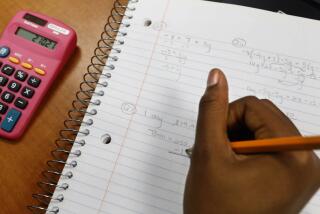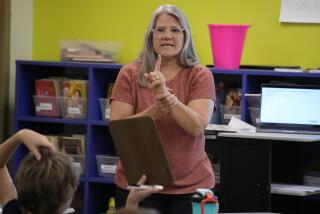We Need Cease-Fire in War Over Best Way to Teach Math
In an address this month to a joint meeting of the American Mathematical Society and the Mathematical Assn. of America, U.S. Secretary of Education Richard W. Riley called for a cease-fire in the “math war” that has raged in California and school districts across the country.
The war pits “reformers”--who worry that American students can crunch numbers but can’t use them thoughtfully--against back-to-basics advocates, who say that some things must be practiced over and over until they are memorized, not as a substitute for thinking but as an aid to it. The rhetoric got especially heated in December, when the State Board of Education in California adopted academic standards that emphasized the traditional approach, outraging the reformers.
Here are excerpts from Riley’s speech:
Almost 90% of new jobs require more than a high school level of literacy and math skills. An entry level automobile worker needs to be able to apply formulas from algebra and physics to properly wire the electrical circuits of a car. That is why it is so important that we make sure that all students master the traditional basics of arithmetic early on--as well as the more challenging courses that will prepare them to take physics, statistics and calculus in high school and college.
This undeniable and critical increase in the value of challenging mathematics for both individual opportunities and our society’s long-term economic growth leads me to an issue about which I am very troubled--the increasing polarization and fighting about how mathematics is taught.
It is perfectly appropriate to disagree on teaching methodologies and curriculum. But what we need is a civil and constructive discourse. I am hopeful that we can have a cease-fire in this war--and instead harness the energies employed on these battles for discourse.
One way to begin such a crusade is to start with the facts. While our students aren’t yet performing at the level we want, they are doing better than many Americans think.
Mathematics scores from the National Assessment of Education Progress, the nation’s report card, increased significantly from 1990 to 1996 at all levels tested. In addition, over the past two decades, more students are taking Advanced Placement mathematics courses, SAT and ACT mathematics scores are up and more high school graduates are taking more years of mathematics--51% of students completed three years compared to only 13% in 1982.
There is also some positive news when you compare our students with those of other nations. The recent Third International Mathematics and Science Study [shows] U.S. fourth-graders are near the very top in achievement in science. [But it] also revealed that the United States was the only country whose students dropped from above average performance in mathematics [in fourth grade] to below average performance in the eighth grade.
Why is our competitive position dropping in the middle grades? It’s surely not because our kids can’t master challenging material. And it’s not because most don’t know the basic skills of arithmetic.
In fact, NAEP trend data, released in August of this year, shows that fully 79% of eighth-graders “can add, subtract, multiply and divide using whole numbers and solve one-step problems.”
This leads me back to the need to bring an end to the shortsighted, politicized and harmful bickering over the teaching and learning of mathematics. If we continue down this road of infighting, we will only negate the gains we have already made--and the real losers will be the students.
We are suffering here from an “either-or” mentality. As any good K-12 teachers will tell you, to get a student enthused about learning, you need a mix of information and styles. Different children learn in different ways and at different speeds. A good teacher will do whatever he or she can to reach that child.
I believe that there is a “middle ground” between these two differing views of how to teach mathematics. We all want our students to master the traditional basics--to be able to add, subtract, multiply and divide, and be accurate and comfortable with simple mental and pencil and paper computation.
There are, of course, examples of questionable practices and teaching methods on both sides of this debate. As [University of Georgia math professor Jeremy] Kilpatrick pointed out: “Change in education is notoriously complex, difficult and unpredictable. Reform movements in mathematics education turn out neither as advocates hope nor as detractors fear. But these movements can energize those teachers who want . . . to teach better mathematics and to teach mathematics better.”
It is time we focused on the students and the interest of our nation--on what really helps kids learn--not on what the process for learning is called.
More to Read
Sign up for Essential California
The most important California stories and recommendations in your inbox every morning.
You may occasionally receive promotional content from the Los Angeles Times.










